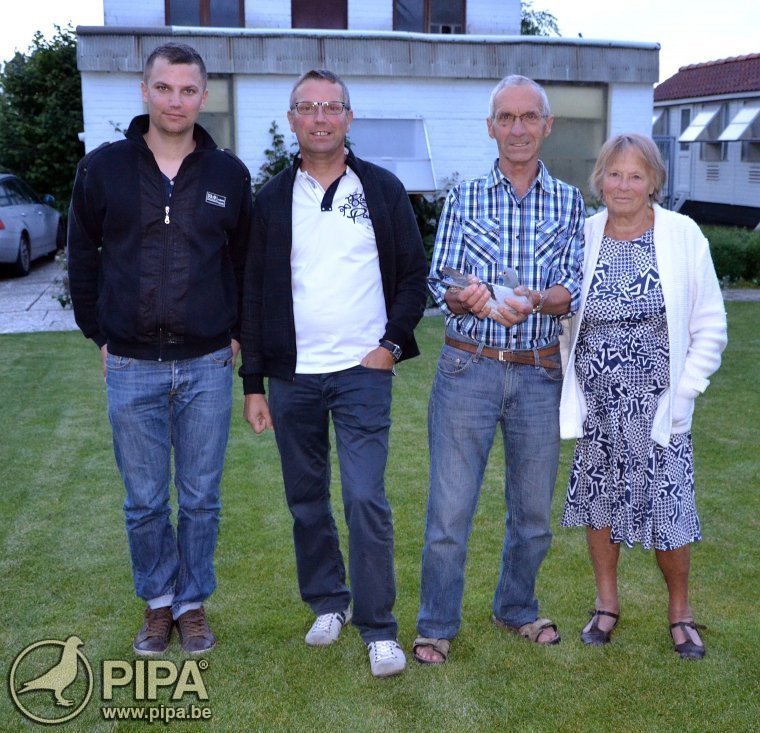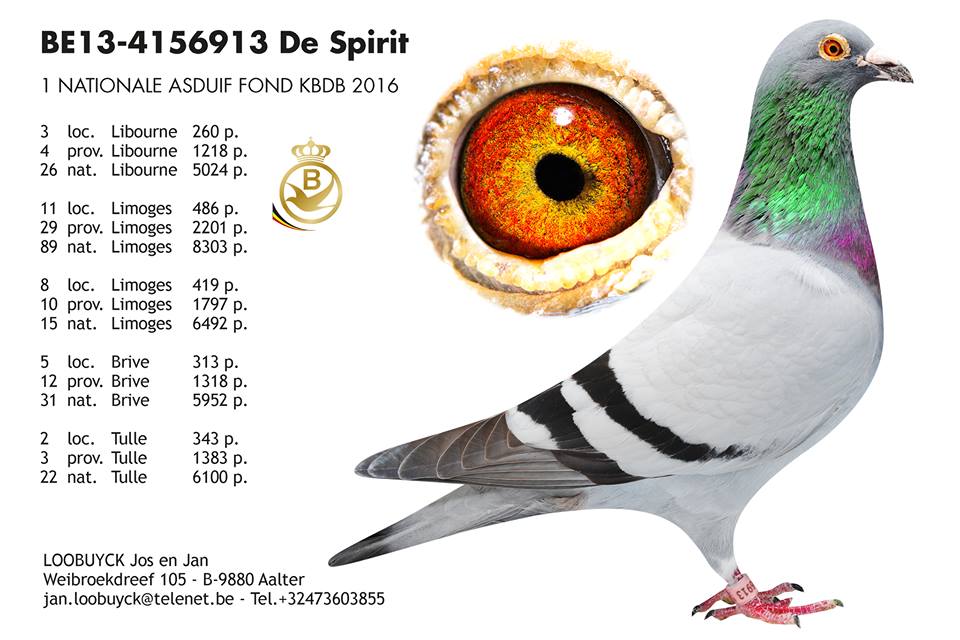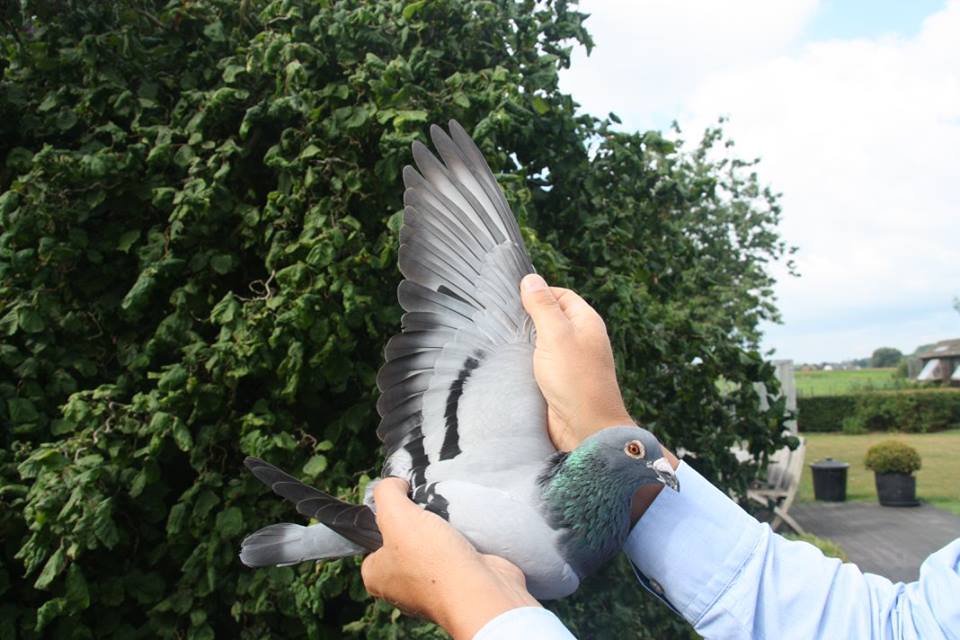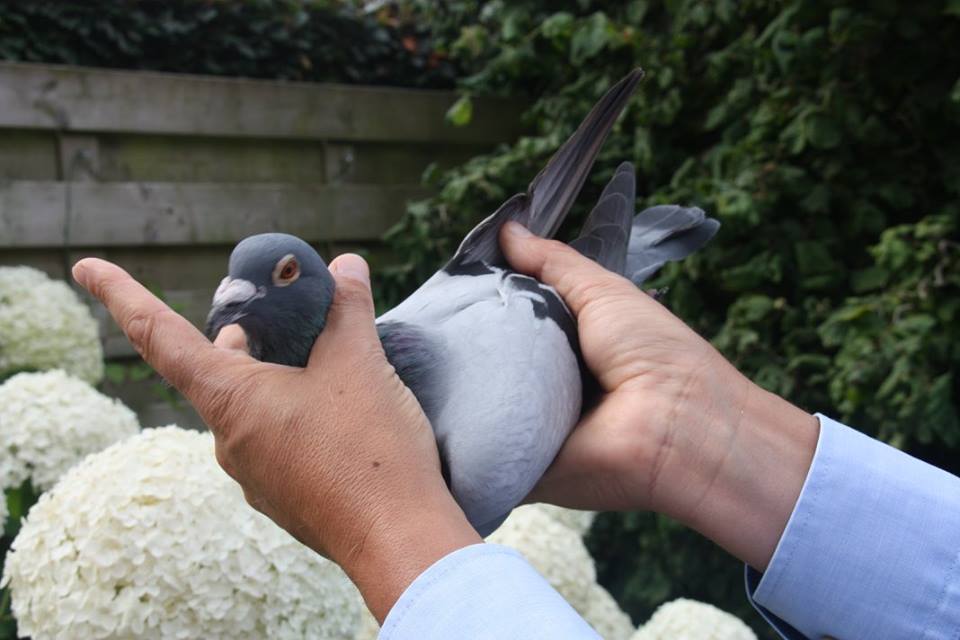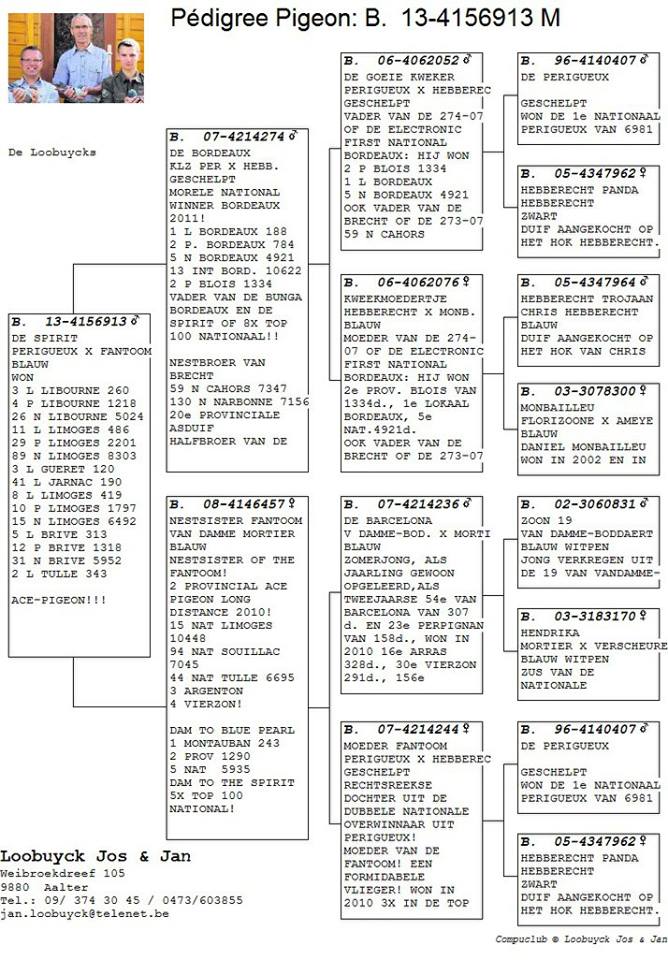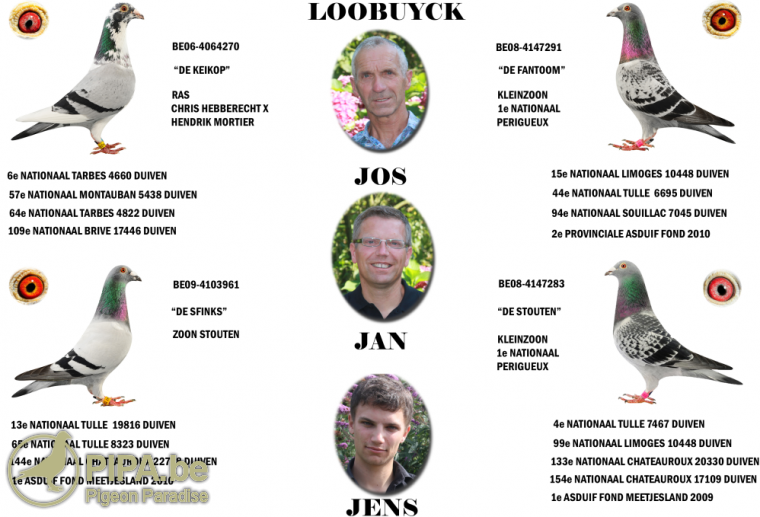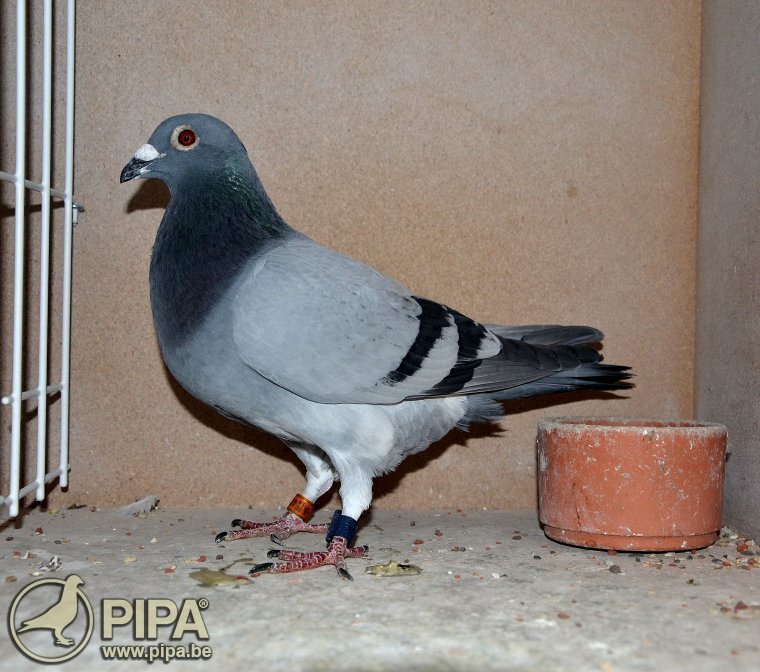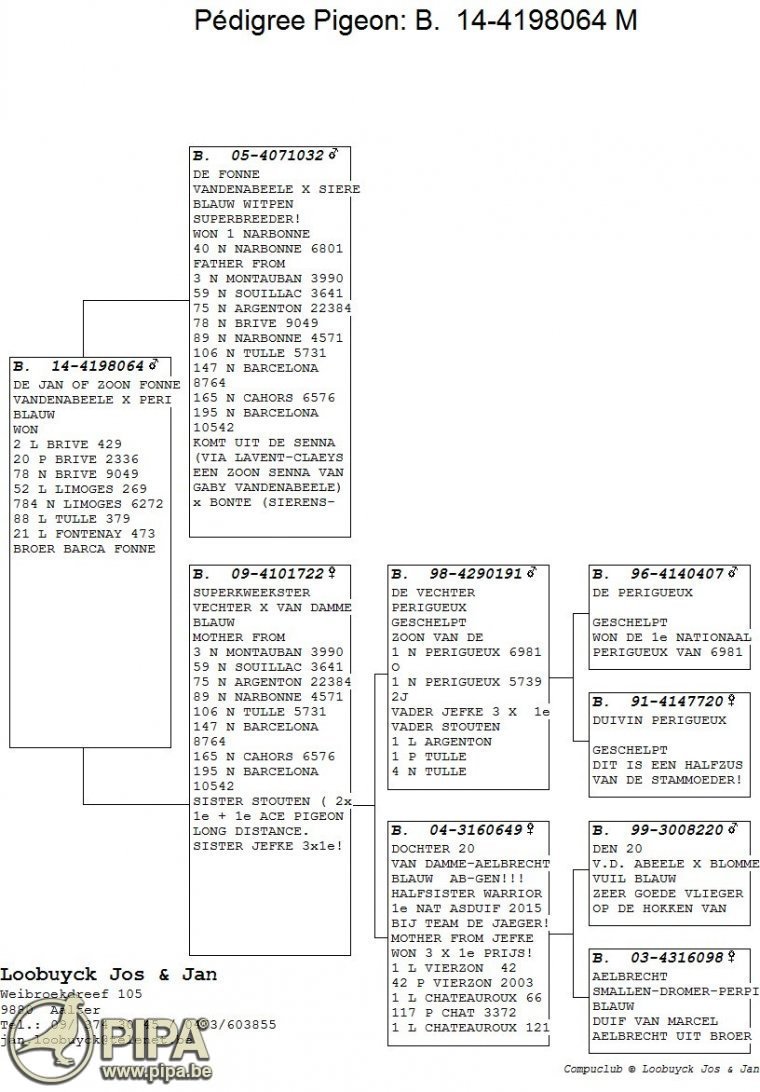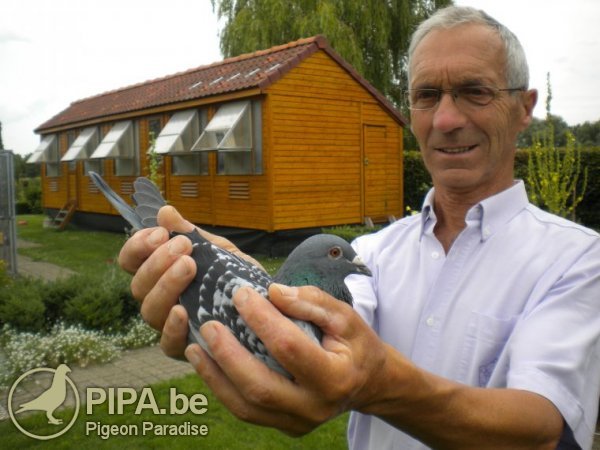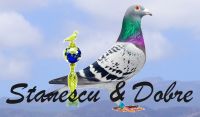Un interviu in premiera pentru toti iubitorii de fond, maraton si nu numai. Un interviu cu unii dintre cei mai buni fondisti belgieni ai ultimilor 20 de ani. In momentul in care l-am felicitat pe Jan pentru minunatul titlu obtinut acest an, prin super porumbelul SPIRIT, l-am intrebat daca este de acord sa realizam impreuna un articol-interviu pentru columbofilii romani. A fost de acord, si astfel, a iesit acest interviu, interesant cred eu pentru toti columbofilii, indiferent de categoria preferata.
Lectura placuta 🙂
* SPIRIT” – 1 National Fond Maturi Belgia KBDB 2016 !!!
1. Te rugam sa ne spui cateva cuvinte despre familia ta, si despre locul pe care il ocupa sportul columbofil in familia ta.
La inceputul anilor ’60, tatal meu s-a apucat de porumbei, si eu am inceput sa arat interes fata de porumbei, inca de mic copil, undeva la sfarsitul anilor ’60. Undeva la mijlocul anilor ’70, a luat nastere actualul tandem – Jos si Jan Loobuyck. Marie-Antoinette, sotia lui Jos si mama mea, a ajutat dintotdeauna cum a putut tandemul. In urma cu cativa ani, fiul meu, Jens, s-a alaturat tandemului.
2. Ai debutat de la bun inceput in cadrul etapelor de fond si de maraton?
Nicidecum. La inceput am participat doar in cadrul curselor de pana in 400 km. Asta pentru mai bine de 20 de ani. Undeva la mijlocul anilor ’80 am inceput sa fim interesati din ce in ce mai tare de etapele de fond si maraton. Pas cu pas am inceput sa participam in cadrul etapelor cu distante cuprinse intre 400 si 800 km, folosind etapele de sprint doar pentru antrenament. La finalul anilor ’90 am inceput sa participam si in cadrul etapelor de maraton international precum Marseille si Barcelona, cu rezultate promitatoare. De atunci si pana in prezent, participam in cadrul etapelor cu distante cuprinse intre 500 si 1000 km.
3. Stiu ca baza actuala a coloniei tale este data de porumbeii Hebberecht, si pentru ca personal am o relatie stransa de prietenie cu familia Hebberecht, te-as ruga sa imi spui, cum v-ati decis asupra acestei familii de porumbei ?
Il stim bine pe Chris, deoarece este coleg cu noi de club, la binecunoscutul club de fond-maraton din Eeklo. Undeva in 2004, am cumparat mai multe oua de la Chris, oua din care au iesit niste pui foarte buni la mana. Pe langa aceste calitati exterioare, acestia ne-au reprodus rapid zburatori de top, incrucisati cu linia noastra veche. Astfel a luat nastere fundatia familiei noastre de porumbei din prezent. Din aceasta incrucisare, vreau sa amintesc doi maratonisti de top : Keikop si Diamond.
4. Ce metoda de zbor folosesto? daca folosesti vaduvia clasica, partenerii se vad inainte de imbarcare sau nu?
Zburam conforma vaduviei clasice, atat cu maturii cat si cu yearlingii. La debut de sezon, in cadrul etapelor de sprint, aratam femela inainte de imbarcare, mai ales pentru a invata yearlingii cu sistemul vaduviei. Dar inaintea etapelor de fond si maraton, nu le aratam partenerul, deoarece vrem sa ii angajam cat mai calmi posibil.
5. Cand imperechezi vaduvii si cand incepi vaduvia cu ei?
La inceputul lunii februarie imperechez lotul de zbor si ii las sa cloceasca timp de 10 zile, dupa care ii separ. Inainte de debutul sezonului(aprilie la belgieni), porumbeii sunt lasati impreuna 4-5 zile, dupa care sunt din nou separati, si vaduvia poate astfel incepe propriu zis.
6. Ce parerea ai despre motivatie sau extramotivatie? Ai folosit anumite metode atat cu Perigeux(castigatorul national din 2008), cat si cu Spirit?
Pentru noi motivatia este extrem de importanta in obtinerea unor premii de top. Lui Perigeux i-am adaugat o odihnitoare in fata boxei, si asta a fost o super motivatie pentru el. Cu Spirit a fost ceva asemanator. Am indepartat un vecin de boxa cu el datorita rezultatelor slabe, si am inchis boxa respectiva, montand totusi o odihnitoare in fata ei. Spirit si-a adjudecat-o imediat, si se pare ca aceasta a fost cea mai mare motivatie pentru el intreg sezonul , o extra motivatie ce i-a adus titlul de 1 As Fond Maturi Belgia KBDB 2016.
7. Cat de mult se antreneaza porumbeii tai in jurul crescatoriei?
La inceput de sezon(luna aprilie pentru belgieni), se antreneaza doar seara, timp de 1h, deoarece dimineata este mult prea frig. Incepand cu luna mai, odata cu cresterea temperaturilor, ii antrenez 1 h dimineata si 1 h seara. Cu toate acestea nu sunt antrenati niciodata fortat cu steagul. Imi place sa las porumbeii sa intre natural in forma si in ritm. Pe timp de iarna, las porumbeii liberi o zi pe saptamana, in functie de verme, pentru a se mai dezmorti putin din punct de vedere fizic.
8. Faci antrenamente personale porumbeilor tai inainte de sezon? Dar in timpul sezonului?
Inainte sa incepem antrenamentele cu clubul, ii ducem personal de 3 ori de la 20 km. Dupa care urmeaza primul antrenament cu clubul de la 40 km. Urmeaza direct doua etape a cate 100 km plus 2 etape a cate 200 km. In timpul sezonului NU ii mai ducem cu masina personala. Ne rezumam doar la cele doua antrenamente zilnice in jurul casei.
9. Cati km preferi sa aiba zburatorii tai “in aripi” inainte de prima etapa nationala de fond?
Prefer sa aiba macar 1000 de km in aripi inainte de prima etapa de fond. De aceea incercam sa urmam urmatorii pasi cu ei: 1 x 100 km, 1 x 200 km, 2 x 300 km, si o etapa de 400 km. Dupa care suntem convinsi ca pot participa cu sanse corecte in cadrul oricarei etape de fond de peste 500 km.
10. Participi doar in cadrul etapelor de fond care iti pot folosi pentru titlul de As Fond, sau incerci sa participi la cat mai multe etape de fond maraton?
In functie de forma porumbeilor, si de conditia lor fizica din momentul respectiv incercam sa participam la cat mai multe etape. Cu toate acestea, preferam sa odihnim porumbeii inainte de o etapa importanta. De aceea , in fiecare sezon pierdem cateva etape, deoarece nu zburam cu un numeric prea mare, astfel incat nu putem acoperi absolut toate etapele de fond, chiar daca ne-am dori asta.
11. Alimentatia este un element extrem de important in cadrul etapelor de fond maraton. Ce ne poti spune legat de acest subiect?
Porumbeii mei sunt hraniti tot sezonul cu amestecul clasic “Vaduvie” de la firma Dhoca. Ultimele 6 mese inainte de imbarcare(3 zile inainte), vaduvii primesc amestecul “Fond Plus” de la aceeasi firma. La intoarcere(de la prima masa), timp de 3 zile(deci tot 6 mese), porumbeii primesc acelasi amestec – “Fond Plus” , pentru a isi reface rezervele. Dupa care, porumbeii sunt trecuti din nou pe amestecul clasic “Vaduvie”.
12. Folosesti alunele crude? daca nu, ce alta sursa de proteina folosesti, si ce extra sursa de grasimi folosesti in alimentatia porumbeilor tai?
Da, folosim alune ca sursa proteica, si mancare de canari ca sursa de grasimi(lipide). In fiecare zi a saptamanii vaduvii nostrii primesc 1 aluna si o lingurita cu mancare de canari.
13. Ce tipuri de grasimi(lipide” folosesti in alimentatia porumbeilor tai, stiind cat de importante sunt rezervele de lipide pentru zborurile de fond si maraton?
Nimic in plus fata de ce v-am mentionat anterior. Amestecul “Fond Plus” de la firma Dhoca, care are un procent ridicat de grasimi. In plus, alunele si mancarea de canari, sunt elementele care completeaza o reteta perfecta din punctul meu de vedere.
14. Ce suplimente folosesti pe post de recuperatori la intoarcerea din curse? Tratezi porumbeii impotriva bolilor respiratorii si a trichomonozei dupa fiecare etapa? Tratezi vaduvii impotriva bolilor respiratorii si inainte de anumite etape?
Porumbeii primesc in apa electroliti la intoarcere. Nu tratam porumbeii orbeste impotriva bolilor respiratorii sau a trichomonozei, nici la intoarcere, si nici inainte de imbarcare. Dupa fiecare etapa prietenul nostru Dr.Ruben Lanckriet vine si ne verifica porumbeii. . Tratam porumbeii DOAR daca este nevoie, niciodata orbeste in timpul sezonului !! DOAR daca este nevoie!
15. Daca tot suntem la capitolul tratamente, te rog sa ne spui daca aplici celebra cura preventiva de 15 zile impotriva salmonelozei, atat de des intrebuintata toamna, imediat dupa marea naparlire.
Niciodata toamna. Folosim o cura de 10 zile impotriva salmonelozei primavara, atat pentru reproducatori cat si pentru zburatori, dupa care la 5 zile ii vaccinam impotriva salmonelozei.
16. Atunci cand ai asemenea rezultate constante de peste 20 de ani, banuiesc ca este destul de greu sa gasesti porumbei de calitate pe care sa ii incrucisezi cu proprii porumbei.
Bineinteles ca nu este usor, dar urmarim in primul rand rezultalele crescatoriei respective pe mai multi ani. Datorita propriilor rezultate, si a porumbeilor buni detinuti, mai multi crescatori de top ne-au contactat in ultimii ani pentru imperecheri comune, din care cu siguranta vor iesi zburatori de valoare.
* Loc 1 national Montauban(791km) in 2016 din 4.327 porumbei la o viteza de 1088 mpm!
17. Preferi selectia la mana, sau lasi cosul sa isi faca datoria?
Preferam bineinteles sa lasam cosul sa isi faca datoria. Cu toate acestea, sunt situatii, in care nu putem verifica puii la zbor, si aplicam selectia la mana. Ma refer aici in special la puii tardivi pe care vrem sa ii oprim. Acestia trebuie sa fie perfecti la mana.
18. Crezi in “Cuplu de Aur”? Daca da, ai detinut vreunul pana acum?
Cred in imperecherile “Bun cu Bun”. Am avut intra-devar in trecut o astfel de pereche, dar acum cautam sa imperechem “bun cu bun”, si aici ma refer la porumbeii nostrii care au un palmares de invidiat pe mai multi ani. Pentru noi, cei mai buni reproducatori s-au dovedi a fi fostii mari zburatrori, dar si descendentii directi din acestia.
19. Daca o pereche reproduce un super campion, precum Spirit de exemplu, lasi perechea impreuna, s-au schimbi partenerii?
Incercam sa pastram perechea impreuna pe mai departe. Avem experiente placute in trecut cu asmenea practica, reproducand mai multi porumbei de top din aceeasi pereche.
20. Crezi in consnguinitate sau in incrucisari?
Credem in ambele metode. Cu toate acestea nu practicam o consanguinitate prea stransa, gen incest. Practicam de asemenea incrucisarea in fiecare an, cu noi porumbei achizitionati.
21. Ce parere ai despre noul fenomen global al columbodroamelor?
Am participat vreo 3 ani la rand in cadrul columbodromului Belgian Masters, dar atat. Pentru mine frumusetea columbofiliei consta in faptul ca ma ocup personal de zburatorii mei, satisfactiile fiind infinit mai mari astfel , din punctul meu de vedere.
22. Este Spirit de vanzare? Daca nu, de curiozitate, cati pui ai oprit din el la matca, si cati la zbor, pentru sezonul 2017?
Spirit este deja vandut, dar nu suntem deloc descoperiti, nici in lotul de matca si nici in lotul de zbor.
English version:
1. Please tell us in few words few things about you, your family tradition in pigeon sport and wich members of the family are actually involved daily in this beautiful passion?
In 1961 Jos Loobuyck started racing his first pigeons and in the late 60’s Jan Loobuyck started participating as a young boy. A few years later the tandem Jos & Jan Loobuyck was formed. The wife of Jos, Marie-Antoinette supported the pigeon racing as from the beginning and helped from time to time with the pigeons. In 2008 the son of Jan, Jens, started being interested in pigeons as well and as from that date he helps where he can.
2. Did you started from the beginning with long distance and marathon races?
No, in the early years we competed on the middle short distances from 200 to 400km. Somewhere in the 80’s we started to show interest in the long distance races. Gradually we started to compete more from 400-800km. The short distance races were used to prepare the birds for the longers distances. And in the late 90’s we started with marathon races as well with some good results out of Marseille and Barcelona. Until this day we specialize in the 500-1000km race distances.
3. I know you have many Hebberecht pigeons at the basis of your family. And because I have a very close relationship with Hebberecht family, and their pigeons are doing good in my loft, please tell me, why you decided to breed quite a lot with this line?
We know Chris Hebberecht because we compete in the same club in Eeklo. We bought some eggs from Chris Hebberecht somewhere around 2004. We started to breed with those pigeons, who were very nicely shaped, and had immediately good results with the Hebberecht pigeons coupled with our own basis Loobuyck family. The both families matched very well. Result was the Keikop who was a superb long distance flyer, as well as the Diamond, both from the race Hebberecht x Loobuyck.
4. What method of racing do you use? If is widowhood, do the partners see eachother before basketing or not?
For the old pigeons & the yearbirds we only use widowhood. In the beginning of the season during the short distance preparing races, we show the partner before basketting. Like this the young yearling birds get to know the system of widowhood. For the long distance we do not show the partners before basketting.
5. When do you pair your pigeons, and when do you start widowhood with them?
In the beginning of February we pair the race birds with their partners. They breed on eggs for 10 days and then the partners are removed. Just before the season starts, the birds see their partners a few days and then the partner is removed and the widowhood starts.
6.What do you think about motivation, or extra motivation? What you used with Perigeux, you national winner, and what did you used with your 2016 National KBDB Ace?
For us motivation is very important to achieve excellent results. For the Perigueux we used an extra sitting place, which he defended against other birds, and from that he got some extra motivation. The ‘Spirit’ this year had a similar motivation. Another bird close to his sitting place was removed because of bad results. There was a small piece of wood that the Spirit conquered as an extra sitting place and that was his extra motivation to win the 1st place KBDB Long distance 2016.
7. How long your pigeons train around the house?
In the beginning of the season they only fly in the late afternoon 1hr and as from May when the temperature starts rising they train in the morning 1hr and in the afternoon 1hr. They are not forced to train with flags or anything, everything happens at the pace of the birds.
During winter time the pigeons fly once a week, depending on the weather, to stretch their wings.
8. Do you road train your pigeons by yourself before the season, and during the season?
In the beginning of the season we road train them three times 20km with some good weather. After that the pigeons go to the club for 1 race of 40km and then they start racing 2x 100km and 2x200km. During the season the birds are not driven around extra by car. They train on the loft twice a day.
9. How many km do you prefer for the pigeons to have “in wings” before the first national long distance flight?
We try to have around 1000km flown before they compete in a long distance raceand we try to give them following rhythm: 1x 100km races, 1×200 km races, 2x 300km races, 1x 400km race and then we assume them ready to compete for the +500km national long distance races.
10. Do you race only the long distance races for the national ace title, or do you try to race all the long distance and marathon national races?
Depending on the form of the birds we try to compete as much races as possible. Although we need to skip some races because we prefer a good rest and good preparation for the birds for the next flight. That is why every season we miss some races because we do not have enough birds to compete every race.
11. Very important aspect concerning long distance racing – tell us all what you want about your feeding system: what type of food, and how do you used it.
The birds are given ‘Vlucht’ food from Dhoca and 3 days before the basketting we start to give them ‘Fond Plus’, energy food, to prepare them for the long distance race. After the race they start again with Fond plus to rebuild the reserves and after 3 days they are given again ‘Vlucht’.
12. Do you use peanuts to your racers? If yes, when, and if not what source of protein do you give them?
Yes, we use peanuts and candyseed. Every day of the week the birds get 1 peanut plus some candyseed additional to their normal food ration.
13. What type of fat do you give to your pigeons to built the reserves?
We use the Fond Plus energy food of Dhoca which gives the birds enough reserve for the long distance races combined with the peanuts and candyseed. A few days before basketting we give this food to build up an energy reserve
14. What do you use for recovery after the race? Do you treat them against respiratory problems or tricho before or after important long distance flight? If yes, how do you do it?
After the race we give them again Fond Plus energy food to recover and rebuild their reserves. In the water we put electrolytes for better recovery. We do not treat against tricho blindly before important races. Before the season we go to the veterinary, Ruben Lanckriet, and he tells us if it is necessary to treat the birds. Only if we see after the race a bird is not feeling well, we go to the vet for treatments.
15. If we are at the “treatments subjects”, do you do the very well known “15 days against salmonella(paratyphoid)” after moulting each year, or not? Preventive treatments generally, or only individual treatments only on sick ones?
No, we only give a treatment against paratyphus before the season to all the birds. 10 days of cure and then an injection after 5 days, is the method we use.
16. When you have very good and constant results like you for more than 20 years, I suppose is very hard to find good pigeons and bloodlines to cross with. For what are you looking on new introductions?
On new introductions we look to the performances of lofts who have good results. The last years we exchanged some birds with good playing people and we try to breed together some youngsters.
17. Do you trust in selecting in hand, or do you prefer the basket?
We definitely prefer selecting by basket but sometimes we use selection in hand if we do not have results yet. For example to select the late young birds who can go to the lofts we use selection by hand.
18. Do you believe in “golden breeding pairs”? If yes, did you had one so far?
We believe in good x good. We have had a golden breeding pair in the past and now we try to breed from the best pigeons of our loft. Those who have shown good results.
19. If a pair produce a super pigeon, like your National Ace this year, do you keep them together further, or not?
If we have a superbird out of a pair we try to keep the parents together to breed other good pigeons. It gave some good results in the past with ‘golden breeding pairs’ who gave multiple good pigeons.
20. Do you believe in inbreeding or in crossing?
We believe in both systems. Although we try not to exaggerate with inbreeding but like to cross the Loobuyck pigeons with other races.
21. What is your opinion about One Loft Races, which are growing more and more, year after year? They might be, even not all of us agree, the future of pigeon racing?
In the past we competed once in the One Loft Race in Nevele. But we prefer to race from the own lofts. We like to work with the birds and to see them flying around the house. And the most fun part of racing the pigeons is to see them come home from a long distance flight and to tend to them.
21. Is your National Ace this year for sale? If not, just for curiosity, how many youngsters from him you will fly next year, and how many you will keep in the breeding loft?
The national Ace the ‘Spirit’ is already sold. Although we have close relatives who will be present on the flying loft as well as the breeding loft.

